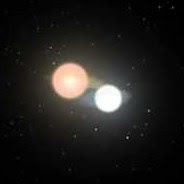Algol, perhaps the best-known of the eclipsing binaries, was the first to be discovered by astronomers. Perhaps the ancients suspected that it was out of the ordinary; at any rate, the name "Algol," which means "the demon" in Arabic, may have referred to the bizarre quality of the supposed star's light, alternately becoming brighter and then dimming.
It was an English deaf-mute, John Goodricke, who in the year 1783 first discovered the nature of Algol's fluctuations. He advanced the theory that what appeared to be a single star was really made up of two: a bright star and a fainter companion that eclipsed the bright star as it revolved around it. He noted that the light of Algol becomes dimmer at intervals of about two days and twenty-two hours. Goodricke's theory was later fully confirmed.
Much has been learned since his day about the two stars that make up the eclipsing binary Algol. The brighter of the two — the primary star — has a diameter three times that of the Sun. Its companion is somewhat larger, but is fainter by three magnitudes. The centers of the two stars are about 13,000,000 miles apart. Their orbits are almost edgewise to the earth; they are inclined from the edgewise position by only 8° or so.
Another interesting eclipsing binary is Zeta Aurigae. It is made up of a blue star, whose diameter is about seven times that of the Sun, and a red star, with a diameter about fourteen times that of its companion. The two stars have approximately the same apparent magnitude. They revolve about each other once every 172 days, eclipsing each other at intervals as they move in their orbits. First we see a partial eclipse, lasting thirty-two hours, then a total eclipse of thirty-seven days and finally another thirty-two-day partial eclipse.
The components of certain eclipsing binaries are so close together that they appear as a single star even when viewed through the most powerful telescope. They have been discovered and studied, however, with the spectroscope. The two stars of a typical binary of this kind approach the Earth and then recede from it in their orbits, unless these are at right angles to the line of sight of an observer on the Earth. The motions of the stars can be analyzed with the help of the spectroscope because, in accordance with the Doppler effect, the lines in their spectra shift to the violet as they approach the Earth and to the red as they recede from it. Binary systems that are analyzed by means of the spectroscope are called spectroscopic binaries.
